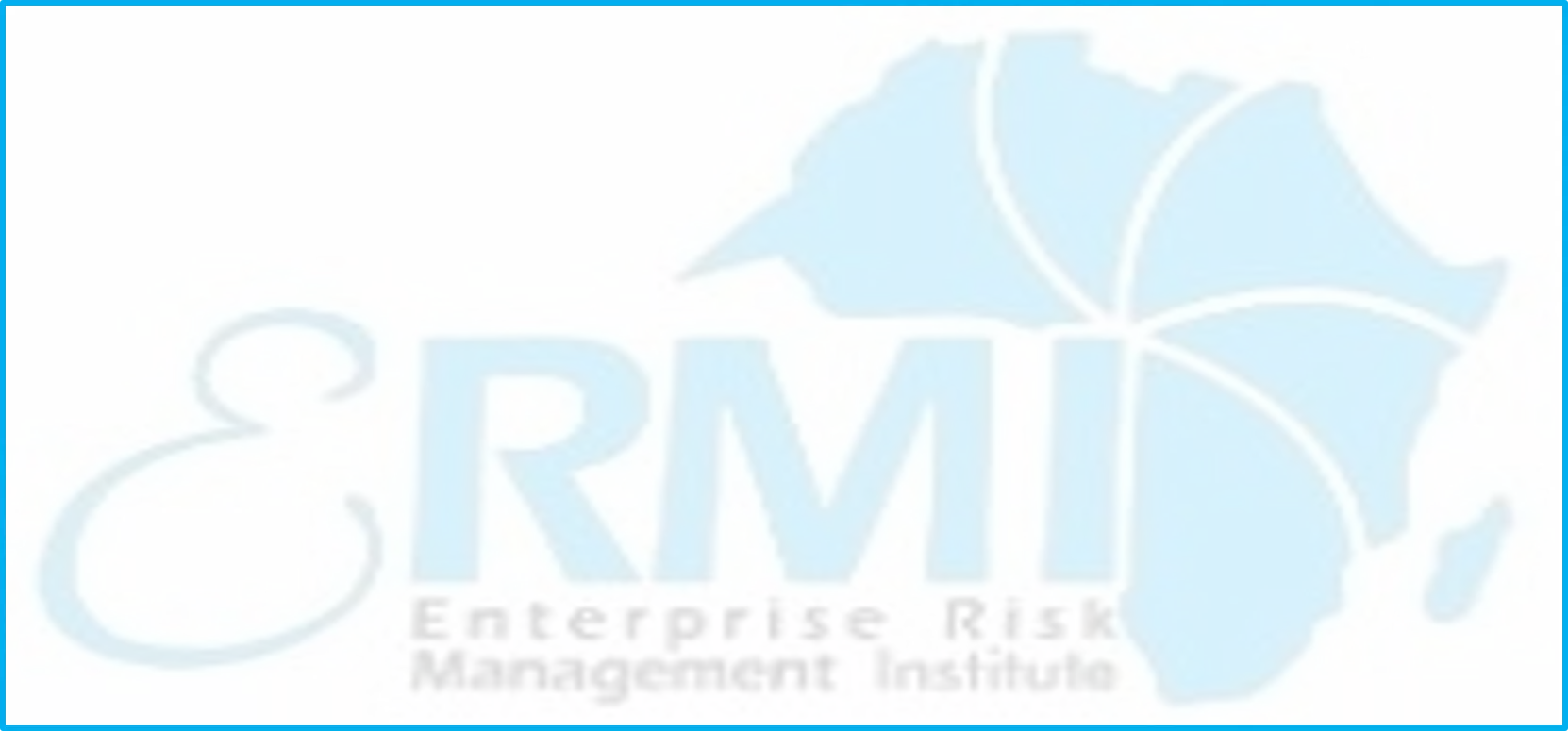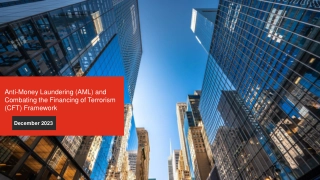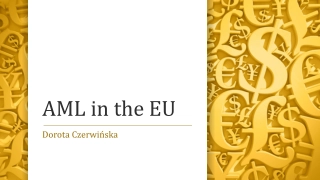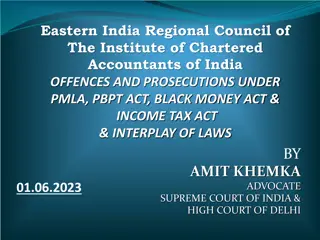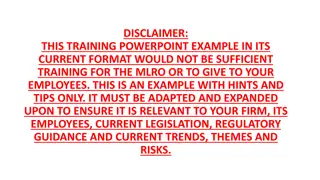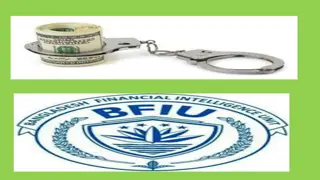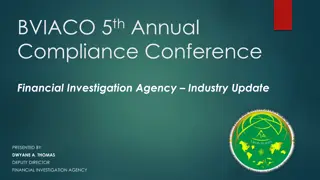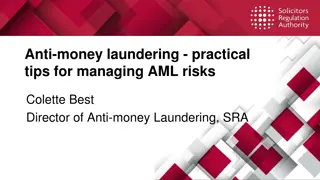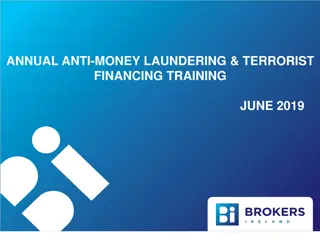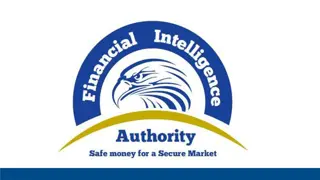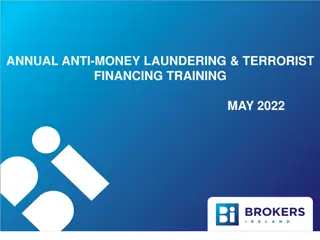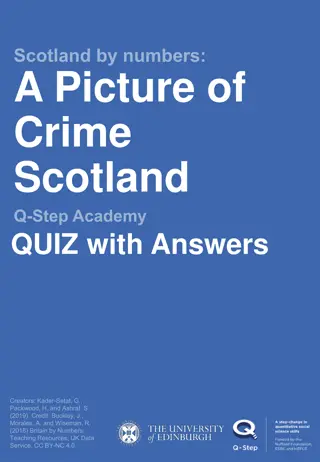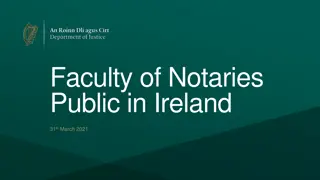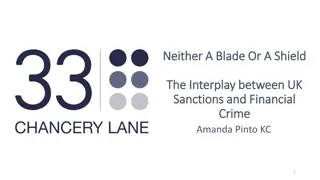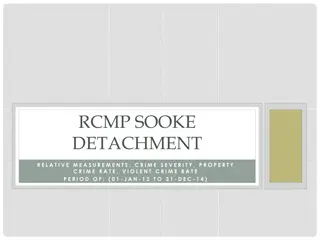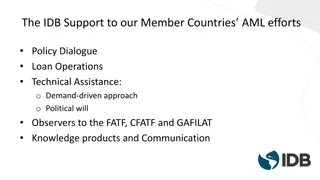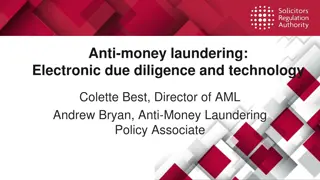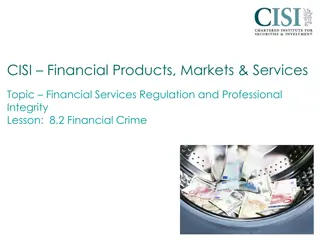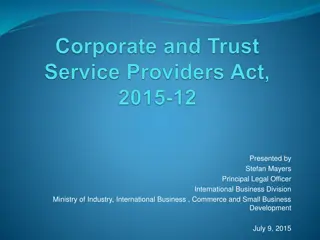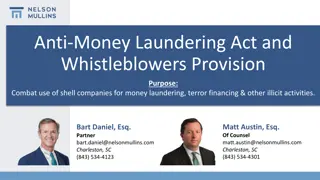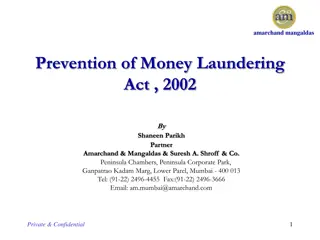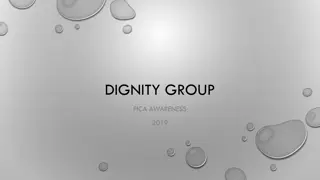Advanced Financial Crime Investigations and Anti-Money Laundering Overview
Explore the world of advanced financial crime investigations, anti-money laundering, and the importance of estimating financial reporting errors. Delve into the role of internal audit and investigations, understand the significance of changes in accounting estimates, and learn why estimation is vital in financial statements. Discover where estimation is required and why changes in accounting estimates are necessary in today's financial landscape.
Download Presentation

Please find below an Image/Link to download the presentation.
The content on the website is provided AS IS for your information and personal use only. It may not be sold, licensed, or shared on other websites without obtaining consent from the author. Download presentation by click this link. If you encounter any issues during the download, it is possible that the publisher has removed the file from their server.
E N D
Presentation Transcript
FINANCIAL CRIME INVESTIGATIONS Advanced Financial Crime Investigation & Anti - Money Laundering www.ermigh.com +233 (055 808 3643, 055 047 4673) info@ermigh.com
Presenters Profile Sina Kamagate is a Chartered Accountant, Chartered Banker and a faculty member of the National Banking College, Accra. Sina holds Master of Research in Finance and is currently pursuing a Doctoral programme in Finance. Sina also holds Association Cambiste International (ACI) in Treasury Management. He has over 10 years experience in finance and accounting, having work with EY Ghana, Fidelity bank and currently the Chief Internal Auditor of GCB Bank Ltd. He lectures Risk Management, Corporate Governance, Treasury Management and Finance of International Trade at the Chartered Institute of Bankers (Gh). www.ermigh.com +233 (055 808 3643, 055 047 4673) info@ermigh.com
Overview Estimates in Financial Reporting Errors Fraud in Perspective (Financial Crime) Internal Audit & Investigations Understanding Investigations www.ermigh.com +233 (055 808 3643, 055 047 4673) info@ermigh.com
Change in Accounting Estimate? IAS 8 An adjustment of carrying amount of an asset or liability; An adjustment of the amount of periodic consumption of an asset; that results from the assessment of the present status of assets and liabilities Expected future benefits of assets Obligations associated with liabilities Change in accounting estimates result from: New information; or New developments www.ermigh.com +233 (055 808 3643, 055 047 4673) info@ermigh.com
Reason for Estimation When an item of financial statements cannot be measured precisely, it can only be estimated. This is because of: Uncertainties inherent in the business; Where judgments are involved; www.ermigh.com +233 (055 808 3643, 055 047 4673) info@ermigh.com
Where Estimation is Required? Estimates may be required of: Impairment of financial instruments; Inventory obsolescence; Fair value of financial assets or financial liabilities; Warranty obligation etc www.ermigh.com +233 (055 808 3643, 055 047 4673) info@ermigh.com
Change in Accounting Estimate Change in the accounting estimate becomes necessary: If changes occur in the circumstances on which the estimate was based; or As a result of a new information; or More experience ERRORS ? www.ermigh.com +233 (055 808 3643, 055 047 4673) info@ermigh.com
Definition of Errors An error is a financial misstatement that was not caused intentionally. In other words, unintentional misstatement of entries. An accounting error can include discrepancies in figures, or might be an error in using accounting policy incorrectly (i.e., a compliance error). Accounting error should not be confused with fraud,which is an intentional error in an accounting item, usually to hide or alter data for personal gain. www.ermigh.com +233 (055 808 3643, 055 047 4673) info@ermigh.com
Definition of Errors www.ermigh.com +233 (055 808 3643, 055 047 4673) info@ermigh.com
Types of Errors Error of Principle Error of Omission Error of Commission Complete Reversal of Entries Compensating Errors Error of Transposition www.ermigh.com +233 (055 808 3643, 055 047 4673) info@ermigh.com
FRAUD????? www.ermigh.com +233 (055 808 3643, 055 047 4673) info@ermigh.com
Defining Fraud (Financial Crime) ..a deliberate act of omission or commission by any person, carried out in the course of a banking transaction or in the books of account maintained manually or under computer system in banks, resulting into wrongful gain to any person for a temporary period or otherwise, with or without any monetary loss to the bank. www.ermigh.com +233 (055 808 3643, 055 047 4673) info@ermigh.com
Who to Look Out For In How to Embezzle a Fortune , Bev Harris says that fraudsters and embezzlers are the nicest people in the world: People who profess deep religious commitments CAs/ACCAs with impeccable resumes Loyal business managers who arrive early, stay late, and never take a vacation Your best friend Your partner Family members www.ermigh.com +233 (055 808 3643, 055 047 4673) info@ermigh.com
WHY..? Loyal employees have bills to pay and families to feed. IN A GOOD ECONOMY, they would never think of committing fraud against their employers. BUT ESPECIALLY NOW, organizations must be vigilant during these turbulent times by ensuring proper fraud prevention procedures are in place. www.ermigh.com +233 (055 808 3643, 055 047 4673) info@ermigh.com
Why People Commit Fraud Most people who commit fraud against their employers are not career criminals. The vast majority are trusted employees who have no criminal history and who do not consider themselves to be lawbreakers. So the question is, what factors cause these otherwise normal, law- abiding persons, to commit fraud? The best and most widely accepted model for explaining why "good people" commit fraud is the FRAUD TRIANGLE. This is a model developed by Dr. Donald Cressey, a criminologist whose research focused on embezzlers, people he called "trust violators." www.ermigh.com +233 (055 808 3643, 055 047 4673) info@ermigh.com
The Fraud Triangle www.ermigh.com +233 (055 808 3643, 055 047 4673) info@ermigh.com
Pressure Inability to pay one's bills Drug or gambling addiction Need to meet earnings to sustain investor confidence Need to meet productivity targets at work Desire for status symbols such as a bigger house, nicer car, etc. Threat of imminent bankruptcy, foreclosure or hostile takeover Non-shareable problems and the importance of status www.ermigh.com +233 (055 808 3643, 055 047 4673) info@ermigh.com
Opportunity The nature of the industry or the entity s operations may provide opportunities to engage in fraudulent financial reporting due to: Domination of a certain industry sector that allows the entity to dictate terms or conditions to suppliers or customers that may result in inappropriate or non arm s- length transactions Assets, liabilities, revenues or expenses based on significant estimates that involve subjective judgments or uncertainties that are difficult to corroborate www.ermigh.com +233 (055 808 3643, 055 047 4673) info@ermigh.com
Opportunity Significant operations located or conducted across international borders in jurisdictions with differing business environments and cultures Management may be ineffective in its monitoring due to: Domination of management by a single person or small group, in a non owner-managed business, without compensating controls Ineffective oversight over the financial reporting process and internal control by those charged with governance The organizational structure may be too complex www.ermigh.com +233 (055 808 3643, 055 047 4673) info@ermigh.com
Opportunity Difficulty in determining which individuals have a controlling interest in the entity Overly complex organizational structure involving unusual legal entities or managerial lines of author Significant, unusual or highly complex transactions, especially those close to year-end, that pose difficult substance over form questions www.ermigh.com +233 (055 808 3643, 055 047 4673) info@ermigh.com
Rationalisation The third leg of the fraud triangle is rationalization. As we stated already, the vast majority of fraudsters are first-time offenders with no criminal past. They do not view themselves as criminals. They see themselves as ordinary, honest people who are caught in a bad set of circumstances. Because the fraudster does not see himself as a criminal, he must justify the crime to himself in a way that makes it an acceptable or justifiable act. This is known as rationalization. Common rationalizations include the following: I was only borrowing, I must get my fair share, the bank is not been fair www.ermigh.com +233 (055 808 3643, 055 047 4673) info@ermigh.com
Fraud Trends 1990 1999 Ponzi schemes Fake currency Cheque forgery Advancing loans without adequate due diligence Siphoning of investors money through fictitious companies Use of fictitious government securities www.ermigh.com +233 (055 808 3643, 055 047 4673) info@ermigh.com
Fraud Trends 2000 2015 Tax evasion and money laundering Cybercrime Debit/credit card fraud Identity theft Collusive frauds emanating kickbacks to employee of financial institutions Use of forged instruments such as stamp papers and shares Violation of Know Your Customer (KYC) norms www.ermigh.com +233 (055 808 3643, 055 047 4673) info@ermigh.com
Fraud Trends 2015 to date Tax evasion and money laundering Cybercrime Debit/credit card fraud Cash suppression Social engineering Use of forged instruments such as stamp papers and shares / clone cheques Violation of Know Your Customer (KYC) norms www.ermigh.com +233 (055 808 3643, 055 047 4673) info@ermigh.com
Managing the Risk Managing fraud risks and factors Cultivate and demonstrate an honest and ethical corporate culture Be skeptical, inquisitive and diligent Understand fraud risks, including potential management override of controls and potential fraud related to revenue recognition Discuss fraud risks with other audit committee members Communicate with management and the auditors about fraud risks, known and suspected fraud, and controls to prevent and detect fraud www.ermigh.com +233 (055 808 3643, 055 047 4673) info@ermigh.com
Combating the Challenge Technology Solutions Awareness/ Training Policy Changes www.ermigh.com +233 (055 808 3643, 055 047 4673) info@ermigh.com
Awareness Customer awareness Newspapers & other media SMS alerts Emails Staff awareness Training programmes Practicals Online Culture building Rewarding fraud preventers www.ermigh.com +233 (055 808 3643, 055 047 4673) info@ermigh.com
Internal Audit & Investigation Internal audit is an assurance and consulting activity designed to add value to and improve an organisation s operations. This is done through evaluating a company's internal controls, including its corporate governance and accounting processes. It is mainly driven by the three lines of defence model for effective governance, risk management and control. www.ermigh.com +233 (055 808 3643, 055 047 4673) info@ermigh.com
Internal Audit & Investigation An investigation in its general sense is an active effort to find out something, involving a systematic process and thorough attempt to learn the facts about something usually complex or hidden. www.ermigh.com +233 (055 808 3643, 055 047 4673) info@ermigh.com
Compare INTERNAL AUDIT A proactive process A continuous process of risk assessment Broader scope Stakeholders are usually clear what to expect Reporting is more general purpose A walkthrough of defined processes Conducted by auditors Laws are not a significant consideration More influential and persuasive in nature INVESTIGATION A reactive process An intentional effort to address an allegation Limited scope Need to conscientize the requestor Private communication of results More than just walkthroughs Conducted by an expert or specialised investigative team Need to be aware of relevant laws Critical and conclusive www.ermigh.com +233 (055 808 3643, 055 047 4673) info@ermigh.com
Assessing the Work Requested Is an investigation required? Identify all stakeholders Outcomes sought by the stakeholder Regulatory or legal concerns Access to available knowledge and sources of information Format of the investigation Legal process Who must be notified Immediate steps www.ermigh.com +233 (055 808 3643, 055 047 4673) info@ermigh.com
Investigation Specific Consideration Physical risk factors and team safety Multi-institution investigations Regulatory and legal factors Language and cultural factors Transportation and coordination Data privacy laws Working with government, local officials and law enforcement www.ermigh.com +233 (055 808 3643, 055 047 4673) info@ermigh.com
Necessary Skills and Resources General considerations include: Investigation subject matter Tasks required Locations involved Specific requirements (e.g., background checks, data analytics, forensic technology) Collaboration with other financial institutions Allocation of common tasks Training and supervision Use of external specialists Expert witnesses www.ermigh.com +233 (055 808 3643, 055 047 4673) info@ermigh.com
Why Planning? Co-ordinate strategy and approach to: Measure progress against objectives Co-ordinate resources Estimate time and cost for completion Identify risks Manage stakeholder expectations www.ermigh.com +233 (055 808 3643, 055 047 4673) info@ermigh.com
Work Plan Development Enables the investigation team to answer: What are our objectives? What actions/ activities are we taking to achieve those objectives? How are we progressing towards achieving our objectives? Have we achieved our objectives at the conclusion of the engagement? www.ermigh.com +233 (055 808 3643, 055 047 4673) info@ermigh.com
Basic Principles- Mandate to Report Design a plan that fits and suits overall approach adopted . Discuss and reconsider Choose the right mix of staff Plan the application of technology and data analytics Allocate objectives to managers Allocate tasks to staff Manage accountability and responsibility Allocate time and expected dates of completion Determine and agree on milestones Record Identify new issues, record, discuss and reconsider Mandate reconsider on continuous basis and record limitations and flag for Identify report Investigation objectives Identify assumptions and flag for report Sub-objectives Consider results and possible amendment to plan Activities Consider results as deliverable and flag for report amendments Tasks Prepare report Continuous process of management and reconsideration of tasks, time and output until completion www.ermigh.com +233 (055 808 3643, 055 047 4673) info@ermigh.com
Typical Tasks for an Incident Understand 1. Obtain all relevant documents in support of the particular transaction 2. Understand the relationship and interaction between the various documents 3. Map out the transaction in the process considering amounts, dates, relativity of documents with each other and individuals that performed certain actions in the process 4. Where possible, interview individuals to obtain a better understanding (only in instances where it will not create unnecessary suspicion) Gather and analyse 1. Extract associated with the incident such as the same vendor through data analytics 2. Extract documents in support of the above extraction 3. Supplement the data extracted above with information that is not captured but critical in our understanding obtained above 4. Extract transactions through data analysis that fit a similar pattern based on the understanding obtained above (the data analysis should be applied across all parts of the business to determine whether similar patterns exist elsewhere) or summarise transactions www.ermigh.com +233 (055 808 3643, 055 047 4673) info@ermigh.com
Typical Tasks for an Incident Gather and analyse (cont d) Select 5. Advise other affected work streams of results affecting their areas of investigation 1. Based on the analysis performed through the gathering and analysis tasks, identify those that are confirmed to be suiting the pattern 6. Repeat tasks 1 to 3 above on additional transactions identified through the data analysis 2. Select from those transactions for detailed investigation (agree with team leader on selection) 7. If no more transactions are identified, reconsider our understanding, conclude, document conclusion and continue to investigate the known instances 3. Prepare a schedule reflecting the selection made and extend information such as individuals affected and other information not captured in the data but required for further investigation with additional www.ermigh.com +233 (055 808 3643, 055 047 4673) info@ermigh.com
Typical Tasks for an Incident Investigate Conclude and report 1. Collate documentation in support of the schedule prepared in task 2. in the selection part (main exhibits) Identify individuals and collate additional sets of documents per individual (interview exhibits) Perform interviews with individuals, using documentary and other support as basis Evaluate results of interviews and consider whether our understanding was correct and accurate as well as whether our findings are conclusive. 1. Consider the findings made and conclude whether the transactions are isolated instances. If so, prepare a report on the findings made either as an isolated instance or as part of a pattern When reporting on patterns, consider the use of schedules and tables to capture the pattern in the report as opposed to a discussion on individual transactions 2. 2. 3. 4. www.ermigh.com +233 (055 808 3643, 055 047 4673) info@ermigh.com
Typical Tasks for an Incident UNDERSTAND Gather and analyse 1. Obtain a clear understanding of the relevant pattern Identify reasons and support for assessment and conclusion on risk pattern Determine, based on our process analysis already completed, the various elements of the transaction cycle (if the process is not fully understood at this point, proceed to task 4) Select a transaction and map out the transaction in the process considering amounts, dates, relativity of documents with each other and individuals that performed certain actions in the process Based on task 4, confirm our understanding of the process and only if still not completely understood, conduct additional interviews 1. Extract or summarise transactions associated with our understanding of potential pattern Extract documents in support of the above Supplement the data extracted above with information that is not captured but critical in our understanding obtained above 2. 2. 3. 3. 4. 5. www.ermigh.com +233 (055 808 3643, 055 047 4673) info@ermigh.com
Typical Tasks for an Incident Gather and analyse (cont d) 5. Extract transactions through data analysis that fit a similar pattern based on understanding obtained above (the data analysis should be applied across all parts of the business to determine whether similar instances exist elsewhere) 6. Advise other affected work streams of results, affecting their areas of investigation 7. Repeat tasks 1 to 3 above on additional transactions identified through the analysis 8. If no more transactions are identified, reconsider our understanding, conclude, document conclusion and continue to investigate the known instances If more instances are identified, continue to investigate selection of instances separately Select 1. Based on the analysis performed through the gathering and analysis steps identify those transactions that are confirmed to be suiting the pattern 2. Proceed to investigate instances selected for investigation see Incident tasks briefing the data www.ermigh.com +233 (055 808 3643, 055 047 4673) info@ermigh.com
Planning Deliverables Beginning at the end, consider the end result: What deliverable will be required to address the issues What information will the deliverable contain Work backwards to determine how and where the team will obtain the information Other factors to consider: To whom are we reporting? Purpose of reporting Progress reporting Format of deliverables www.ermigh.com +233 (055 808 3643, 055 047 4673) info@ermigh.com
Format for Deliverables Purpose Audience Form of deliverable Board, boardcommittees Decisions Conclusions and recommendations, summary in ppt Management Action Full report of findings Lawyers Action Full report of findings and oral evidence Court Litigation Affidavit, sworn statement (written or oral), oralevidence Law enforcement Gathering of evidence Affidavit, sworn statement (written ororal) Law enforcement Litigation Affidavit, oral evidence Regulators Action Full report of findings and evidence Arbitration Dispute resolution Affidavit, oral evidence Mediation Bringing parties to solution Briefing note, explanatoryschedules Disciplinary hearings Labour dispute resolution Oral evidence www.ermigh.com +233 (055 808 3643, 055 047 4673) info@ermigh.com
Subcontractors Forensic subcontractors Circumstances in which the services of a subcontractor may be needed: Document analysts Handwriting/fingerprint experts Private investigators Industry/sector experts Scanning service providers Sampling expert/statistician Non-forensic subcontractors Circumstances in which the services of a non-forensic professional may be needed: Valuation Determination of quantities or physical characteristics Determination derived by using specialized techniques or methods Interpretation requirements, agreements of amounts of regulations, technical or www.ermigh.com +233 (055 808 3643, 055 047 4673) info@ermigh.com
Key Points to Remember Assess the investigation requested carefully before you begin. You may not have the skills and/or resources to complete it. There may also be things you need to do immediately! Have clear objectives. Periodically confirm the objectives with the stakeholders. Regularly confirm if you are on track. Begin at the end. Be clear on the deliverables. Continually re-evaluate whether there is adequate predication. Maintain a dynamic work plan. www.ermigh.com +233 (055 808 3643, 055 047 4673) info@ermigh.com
Information & Evidence INFORMATION Things that are or can be known about a given topic; communicable knowledge of something Devoid of some or all of the integrity features required for evidence Not per se capable of admission as evidence in a legal dispute forum EVIDENCE Facts presented in support of an assertion Describable capable of assessed for truth of contents Capable of being recognised as evidence and tested in legal dispute forums or observations and being www.ermigh.com +233 (055 808 3643, 055 047 4673) info@ermigh.com
Assessing the Information Consider theend state of the investigation Have a clear understanding of issues Ask questions Alternative sources to obtain various versions of a document Recognise that timing is crucial It is a continuous process www.ermigh.com +233 (055 808 3643, 055 047 4673) info@ermigh.com
Barriers to Gathering Information Ethical barriers Data privacy laws Mandate restrictions Legal process and law of evidence Professional standards Sanctity of contract www.ermigh.com +233 (055 808 3643, 055 047 4673) info@ermigh.com
Determining the Source of Information Medium/ Nature Location Custodian Information management Investigate for sources Technology Feasibility and reasonability Alternatives www.ermigh.com +233 (055 808 3643, 055 047 4673) info@ermigh.com
Sources of Documentary Evidence PUBLIC RECORDS NON-PUBLIC RECORDS By law, a requirement for governmental agencies to keep Information about a person or business considered to be private and confidential Examples: - Real property records - Birth and Death records - Property tax records Examples: - Banking records - Tax records - Credit records of individuals www.ermigh.com +233 (055 808 3643, 055 047 4673) info@ermigh.com











